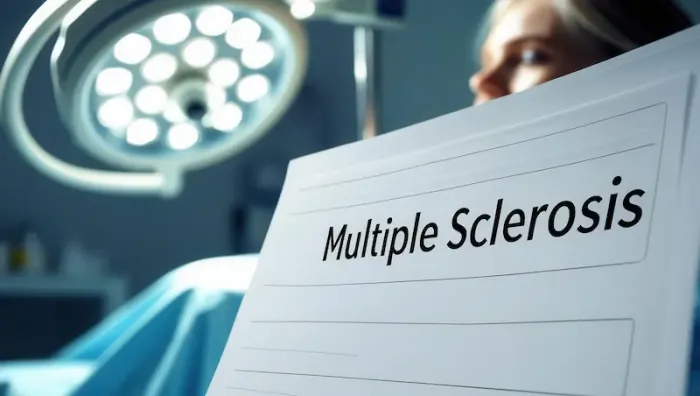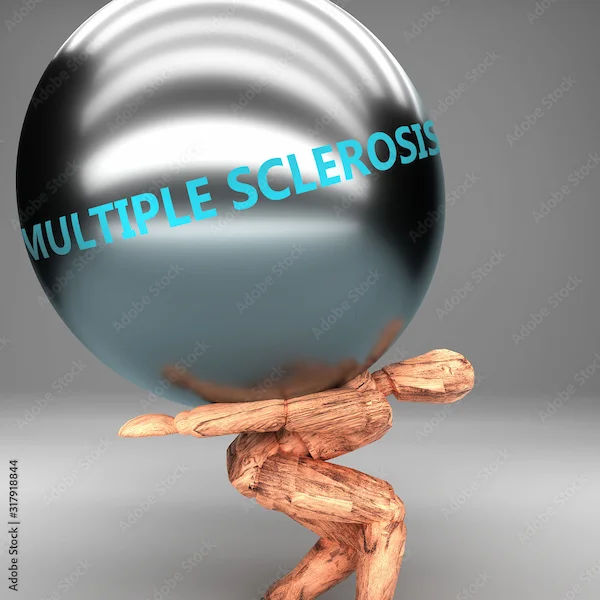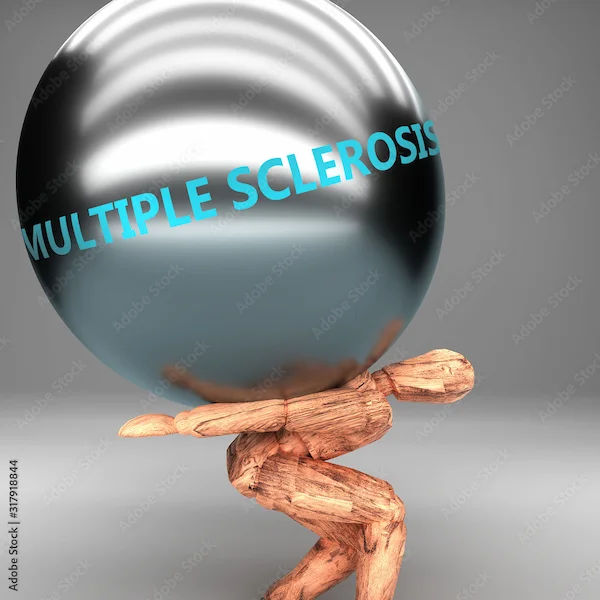Understanding Multiple Sclerosis: Recognising the Signs and Types of the Disease
Learn about multiple sclerosis, its early signs, symptoms, types, causes, diagnosis, and management strategies to support a better quality of life.


Introduction
Imagine your body's nervous system as a complex network of electrical wires. Each wire is insulated by a protective coating that ensures signals travel quickly and efficiently. Now, imagine that insulation begins to fray and break down. The signals short-circuit, slow down, or never reach their destination. This is a simple analogy for Multiple Sclerosis (MS), a chronic disease that affects the central nervous system. For the nearly 2.8 million people living with MS worldwide, this condition presents a unique and often unpredictable journey. This article will guide you through the essential signs of multiple sclerosis disease and explain the different types, empowering you with knowledge about its causes, diagnosis, and how individuals manage life with MS. Whether you're seeking information for yourself or a loved one, understanding these fundamentals is the first step toward navigating this complex condition.
What is Multiple Sclerosis? An Autoimmune Misfire
At its core, multiple sclerosis is an autoimmune disorder. This means the body's own immune system, which is designed to fight off invaders like viruses and bacteria, mistakenly attacks healthy tissue. In the case of MS, the target is the central nervous system (CNS), which comprises the brain and spinal cord.
The Central Nervous System and the Myelin Sheath
The CNS is the command centre of your body. Messages travel along nerve fibres (axons) as electrical impulses. To ensure these impulses travel at high speed, many axons are wrapped in a fatty substance called the myelin sheath. Think of myelin as the insulating plastic coating around an electrical wire.
How MS Disrupts Communication
In MS, the immune system attacks and damages this myelin sheath. This process, called demyelination, leaves scars or lesions (sclerosis means "scars" in Greek). These scars disrupt the flow of electrical impulses. The signals can be slowed, distorted, or completely blocked. This communication breakdown is what leads to the wide variety of symptoms of multiple sclerosis disease, which can vary dramatically from person to person depending on the location and severity of the nerve damage.
Early Signs and Common Symptoms of Multiple Sclerosis
The symptoms of MS are notoriously diverse because they depend on which nerves are affected. However, some signs are more common than others and often serve as early warnings.
Sensory and Physical Symptoms
Numbness, Tingling, and the "MS Hug"
One of the most frequent early signs is altered sensation. This can include numbness, tingling (pins and needles), or a burning feeling in the face, body, arms, or legs. A distinctive symptom is the "MS hug," a painful sensation of tightness or pressure around the chest or abdomen, like being squeezed by a vice.
Vision Problems (Optic Neuritis)
Vision issues are a common red flag. Optic neuritis—inflammation of the optic nerve—can cause blurred vision, pain with eye movement, loss of colour vision (especially reds appearing washed out), or even temporary blindness in one eye. This is often one of the first symptoms that prompts someone to seek medical advice. Consult a Neurologist for the best advice
Fatigue and Weakness
MS-related fatigue is not ordinary tiredness. It's an overwhelming sense of exhaustion that isn't proportional to activity levels and can significantly interfere with daily life. Muscle weakness, often in the legs, can accompany this fatigue, making simple tasks feel arduous.
Motor and Cognitive Symptoms
Difficulty with Walking and Coordination
Damage to nerve pathways controlling movement can lead to difficulty walking, stiffness or spasms in muscles (spasticity), lack of coordination (ataxia), and dizziness or vertigo. These motor symptoms of MS can affect balance and gait.
Cognitive Changes and "Brain Fog"
Many people with MS experience cognitive changes, often called "brain fog." This can include problems with memory, attention, information processing speed, and executive functions like planning and problem-solving. It's important to note that these symptoms are usually mild to moderate but can be frustrating.
Other common symptoms include bladder and bowel dysfunction, sexual problems, and pain. The key characteristic of many MS symptoms, especially in the early stages, is that they may come and go.
The Different Types of Multiple Sclerosis Disease
MS does not follow the same path for everyone. Understanding the different types of multiple sclerosis is crucial for prognosis and treatment. The disease is generally categorised into four main courses.
Relapsing-Remitting MS (RRMS)
This is the most common form, affecting about 85% of people initially diagnosed. RRMS is defined by clear episodes of new or worsening symptoms (relapses or exacerbations) followed by periods of partial or complete recovery (remissions). During remissions, the disease does not seem to progress. This is the typical pattern for early stage multiple sclerosis.
Secondary-Progressive MS (SPMS)
For many, RRMS eventually transitions to SPMS. In this secondary-progressive stage, the disease begins to progress more steadily, with or without occasional relapses. The disability accumulates over time, and distinct periods of remission become less apparent.
Primary-Progressive MS (PPMS)
Approximately 10-15% of people are diagnosed with PPMS. From the onset, this type is characterised by a steady worsening of neurological function and accumulation of disability from the beginning. There are no distinct relapses or remissions, though there may be temporary plateaus.
Clinically Isolated Syndrome (CIS)
CIS refers to a first single episode of neurological symptoms that lasts at least 24 hours and is caused by inflammation and demyelination in the CNS. Not everyone who experiences CIS will develop MS. The likelihood is higher if an MRI shows brain lesions similar to those seen in MS.
What Causes Multiple Sclerosis and Who is at Risk?
The exact cause of multiple sclerosis disease remains unknown, but it's believed to be triggered by a combination of genetic and environmental factors. It is not directly inherited, but having a close relative (like a parent or sibling) with MS increases your risk slightly. Geographically, MS is more common in countries farther from the equator, suggesting a link to vitamin D deficiency from reduced sunlight exposure. Smoking and past infection with the Epstein-Barr virus (which causes mono) are also considered significant risk factors. MS is most commonly diagnosed in people between the ages of 20 and 40, and it affects women two to three times more often than men.
Diagnosing Multiple Sclerosis: The Path to Clarity
There is no single test for MS. Diagnosis involves a process of gathering evidence to rule out other conditions. A neurologist will typically:
• Take a detailed medical history.
• Perform a neurological exam.
• Use Magnetic Resonance Imaging (MRI) to look for scars (lesions) on the brain and spinal cord.
• Possibly conduct a lumbar puncture (spinal tap) to analyse cerebrospinal fluid for immune cells and antibodies.
• Perform evoked potential tests, which measure the electrical activity in the brain in response to stimuli.
If you are experiencing neurological symptoms that concern you, it's essential to consult a specialist. If symptoms like unexplained numbness, vision loss, or persistent weakness occur, consulting a neurologist online with Apollo24|7 for an initial evaluation can be a helpful first step.
Living Well with MS: Management and Outlook
While there is currently no cure for MS, it is a highly manageable condition. Treatment focuses on three areas:
1. Modifying the Disease Course: Disease-Modifying Therapies (DMTs) can reduce the frequency and severity of relapses and slow the progression of disability, especially for relapsing forms of MS.
2. Treating Relapses: Short courses of high-dose corticosteroids can help speed recovery from acute attacks.
3. Managing Symptoms: A wide range of strategies, from medication for fatigue and spasticity to physical therapy, occupational therapy, and lifestyle changes (diet, exercise, stress management), can dramatically improve quality of life.
The outlook for people with MS has never been better. Advances in treatment over the past 25 years have significantly improved long-term outcomes, allowing most individuals to live full, active lives.
Conclusion
Understanding the signs and types of multiple sclerosis disease is fundamental to demystifying this complex condition. From the unpredictable nature of its symptoms to the distinct courses it can take, MS requires a proactive and informed approach to care. Recognising the early warnings—be it unexplained tingling, sudden vision changes, or profound fatigue—can lead to a timelier diagnosis and earlier intervention with effective treatments. The landscape of MS management has been transformed by research, offering hope and the potential for a high quality of life. Remember, a diagnosis of MS is not an endpoint but the beginning of a managed journey. If you suspect you or someone you know may be showing signs, take that crucial first step and seek expert medical guidance to navigate the path ahead with confidence. Consult a Neurologist for the best advice
Consult a Neurologist for the best advice

Dr. Aditendraditya Singh Bhati
Neurosurgeon
18 Years • MBBS(2004), DNB Neurosurgery(2014); MNAMS; Fellow Neuroendoscopy
Delhi
Apollo Hospitals Indraprastha, Delhi
(100+ Patients)

Dr. Ganeshgouda Majigoudra
Neurologist
10 Years • MBBS, MD ( GENERAL MEDICINE) DM (NEUROLOGY)
Bengaluru
Apollo Clinic, JP nagar, Bengaluru

Dr Rajashekar Mummadi
Neurologist
3 Years • MBBS, DNB General Medicine, DRNB Neurology
Hyderabad
Dr Ram's Neuro Clinic, Hyderabad

Dr. E Prabhakar Sastry
General Physician/ Internal Medicine Specialist
40 Years • MD(Internal Medicine)
Manikonda Jagir
Apollo Clinic, Manikonda, Manikonda Jagir
(150+ Patients)

Dr S Selvin
Neurologist
10 Years • MBBS, MD, DM (Neurology), FINR fellowhsip in Interventional Neuro Radiology
Chennai
Apollo Speciality Hospitals Vanagaram, Chennai
Consult a Neurologist for the best advice

Dr. Aditendraditya Singh Bhati
Neurosurgeon
18 Years • MBBS(2004), DNB Neurosurgery(2014); MNAMS; Fellow Neuroendoscopy
Delhi
Apollo Hospitals Indraprastha, Delhi
(100+ Patients)

Dr. Ganeshgouda Majigoudra
Neurologist
10 Years • MBBS, MD ( GENERAL MEDICINE) DM (NEUROLOGY)
Bengaluru
Apollo Clinic, JP nagar, Bengaluru

Dr Rajashekar Mummadi
Neurologist
3 Years • MBBS, DNB General Medicine, DRNB Neurology
Hyderabad
Dr Ram's Neuro Clinic, Hyderabad

Dr. E Prabhakar Sastry
General Physician/ Internal Medicine Specialist
40 Years • MD(Internal Medicine)
Manikonda Jagir
Apollo Clinic, Manikonda, Manikonda Jagir
(150+ Patients)

Dr S Selvin
Neurologist
10 Years • MBBS, MD, DM (Neurology), FINR fellowhsip in Interventional Neuro Radiology
Chennai
Apollo Speciality Hospitals Vanagaram, Chennai
More articles from Multiple Sclerosis
Frequently Asked Questions
1. What are usually the first signs of MS?
The first signs of MS often include sensory changes like numbness or tingling in the limbs, vision problems such as optic neuritis (blurred vision and eye pain), significant fatigue, and difficulties with balance or walking. These symptoms typically appear suddenly and last for days or weeks.
2. What is the life expectancy for someone with multiple sclerosis?
Most people with MS have a normal or near-normal life expectancy. While the disease can cause disability, it is rarely fatal. Advances in treatment and comprehensive care are helping people with MS live longer, healthier lives than ever before.
3. What is the difference between RRMS and PPMS?
The key difference is the disease pattern from the start. RRMS (Relapsing-Remitting MS) involves clear attacks (relapses) followed by periods of recovery (remission). PPMS (Primary-Progressive MS) involves a steady worsening of symptoms from the beginning, without distinct relapses.
4. Is MS hereditary? Will my children get it?
MS is not directly inherited like some genetic conditions. However, having a first-degree relative (parent or sibling) with MS slightly increases the risk. This suggests a genetic predisposition, but environmental factors are also necessary to trigger the disease. The overall risk for a child of a parent with MS remains low (estimated around 2-5%).
5. Can you have mild multiple sclerosis?
Yes, some people have what is termed 'benign MS.' This is a retrospective diagnosis where, 15-20 years after onset, a person has accumulated little to no disability and remains fully functional. However, the course of MS is unpredictable at the beginning.




